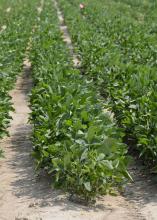Information Possibly Outdated
The information presented on this page was originally released on July 8, 2011. It may not be outdated, but please search our site for more current information. If you plan to quote or reference this information in a publication, please check with the Extension specialist or author before proceeding.
Dry fields put state's soybeans in distress
MISSISSIPPI STATE – The status of the state’s soybean crop depends almost entirely on location, with many east Mississippi fields in good shape while half of Delta fields struggle.
Tom Eubank, a soybean weed scientist and agronomist at Mississippi State University’s Delta Research and Extension Center in Stoneville, said some Delta fields have soybeans setting pods, and others are just being planted.
“In the northern Delta, we have a late crop. In the southern Delta, we have an extremely late crop,” Eubank said. “The more central Delta acres were planted on time.”
South Delta fields were late because of river flooding, while excessive rain kept some north Delta fields too wet to plant on time. The biggest problem now is that the entire Delta is facing severe drought-like conditions.
“Most of the dry land beans are very stressed and not fruiting well at all,” Eubank said. “Where they’ve been irrigated or received some rainfall, the beans look pretty good.”
Eubank said Delta farmers continue to put down wells and irrigate more fields every year in an attempt to harvest decent yields. Without irrigation, Eubank said it is already too late for some dry land beans.
“I’m seeing death on a lot of the sandy fields,” Eubank said. “The clay fields are holding up a little better, but those that haven’t had a rain by early July are in severe decline.”
Dennis Reginelli, Extension area agronomic crops agent in Noxubee County, said soybean fields in the Noxubee and Lowndes county area have received enough scattered rain to show excellent promise.
“We went from May 13 to about June 20 without a drop of rain in this area,” Reginelli said. “I’m surprised at how good some of the soybeans held up in east Mississippi. They were actually growing in some of this intense heat and dry period.”
Scattered rains the last week of June and in early July made a big difference in the growth and development of the crop.
“The plants were sitting there with a good root system just waiting for some moisture,” Reginelli said. “They have responded well, and if we continue to catch timely rainfall, we should have a pretty good soybean crop. It only takes a little bit of rain every week.”
Soybean producers in east Mississippi typically plant on 30-inch rows, rather than the 38-inch rows more commonly found in the Delta. The narrow row allows vegetation from the plants on either side to meet, or canopy over, quickly, helping retain moisture and control weeds.
Looking ahead, it is very likely the Delta’s late soybean crop will have a severe bug season, Eubank said.
“Insect and disease pressure has been very light so far due to the high temperatures and dry environment,” Eubank said. “But as the season goes along, we’ll see increased insect pressure going into the late summer months.”
At that point, producers will have to evaluate insect numbers and the condition of the crop to make decisions about insecticide applications.
“If we do not get some much-needed rain, the crop may be in such dire straits that farmers may choose not to spray,” Eubank said.
For those who harvest a good soybean crop, this year has profit potential. John Michael Riley, Extension agricultural economist, said new crop contract prices at Greenville for beans harvested this coming fall were $13.07 a bushel on July 5. This is higher than in years past but lower than it was just days earlier.
“Prices took a hit when the U.S. Department of Agriculture released its annual acreage report June 30,” Riley said. “Despite soybean acres coming in less than expected, corn led other crops lower, and more soybeans were in storage than expected, both of which pushed prices lower.
“Since then, the market has been higher based on the long-term tight supply situation and the lower acreage number, as well as the flooding occurring in the upper Midwest,” he said.
About 87 percent of Mississippi’s soybean acres had some level of crop insurance in 2010. 2011 data is not yet available. Last year, 22 percent purchased catastrophic coverage, know as CAT, which insures at 50 percent of a total loss. About 50 percent insured their crop at 70 or 75 percent coverage levels.
“Many of the producers with CAT coverage did so to stay in compliance with provisions in the 2008 Farm Bill, and those who bought higher coverage levels likely did so to protect their farm’s livelihood,” Riley said.







